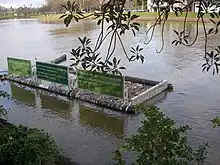
.jpg.webp)
.jpg.webp)
Litter in Australia is prevalent in many areas and a significant environmental problem, particularly in the large cities of Sydney and Melbourne.
An anti-litter movement began in 1969 in Victoria with the formation of Keep Australia Beautiful. Its major anti-littering campaigns "Do the right thing" and "Tidy Towns" became well known nationally. Today, the most vocal organisation is Clean Up Australia which holds a national clean up day.
There is currently no national legislation against litter, because the federal government is not authorised by the Constitution to legislate on such a subject.
Littering is one of the reasons that around 130,000 tonnes of plastic end up in Australian waterways.[1]
In 2006, the most commonly littered item was cigarette butts, followed by items made from paper and cardboard with plastic items a close third.[2]
Legislation
Legislation is generally considered the responsibility of either States and territories of Australia or Local Government Areas. All states and territories now have legislation against littering which may include fines that are enforceable by the police or other agents. Some state environmental protection agencies do online litter reports.
Victoria
In Victoria, the first legislation included the Environment Protection Act (1970) and later the Litter Act (1987).
The responsibility to enforce the regulation is divided between the EPA, Victoria Police, local governments, VicRoads, Parks Victoria and Melbourne Water.[2]
The Environment Protection Authority (Victoria) was the first to facilitate report littering online (based on vehicle registration details) by introducing the appropriate legislation and dispense fines.
Northern Territory
Northern Territory followed with the Litter Act (1972).
South Australia
In South Australia the Container Deposit Legislation (1977) was introduced with the aim of reducing litter by encouraging recycling and remains the only state in Australia with this type of legislation.[3]
Western Australia
Anti-litter legislation was introduced to Western Australia through the Litter Act (1979).
Australian Capital Territory
Litter legislation was introduced to the Australian Capital Territory with the Litter Regulations (1993).
Queensland
In Queensland, litter laws first came into place through the Environmental Protection Act (1994).
New South Wales
In New South Wales, legislation was introduced through the Protection of the Environment Operations Act 1997.
Tasmania
In Tasmania, anti-litter legislation was introduced through the Litter Act (2007).
See also
- Environmental issues in Australia
- Container deposit legislation in Australia (container deposit legislation is an effective measure for reducing litter)
- Waste Management in Australia
References
- ↑ Murray-Atfield, Yara (27 December 2019). "Australians create 67 million tonnes of waste each year. Here's where it all ends up". ABC News. Retrieved 19 December 2023.
- 1 2 "Litter Management in Australia" (PDF). National Environment Protection Council. November 2008. Retrieved 19 December 2023.
- ↑ "Fact Sheets - Container Deposit Legislation (CDL)". www.kesab.asn.au. Archived from the original on 2007-08-31.